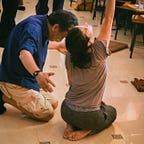BRAZIL: TPS AND EDUCATION
Escola Waldorf Rural Turmalina, Paudalho, Pernambuco, Brazil
Moema Cruz
“ Nature makes of man simply a ‘being of nature’;
society makes him a being who acts according to given laws;
he can become a free ‘being’ only by his own right. “
{Rudolf Steiner}
We started the Arts Course classes with the body. The 17 youngsters between 16 and 17 years old at the Escola Waldorf Rural Turmalina were experiencing the Social Presenting Theater for the first time, as an introduction to Clay Modeling classes. The course proposal was to model sculptures with encounters between two people.
My goal: to make a prototype for the completion of Advanced TPS (Latin America), experimenting with body activities to raise individuality and identity in the school and teaching environment.
So, at each class, before the students played the clay, we practiced the 20-minute Dance, then including the Duets, and at the end of the course, we did the Village. Although some students moved timidly or cautiously, we were all together in practice and then sharing the experience. About Duets, young people found many qualities in the meetings: opposition, complementarity, filling, emptiness, reflection, flow, lines, invitation, imitation, reception, denial, adjustment and also conversation. And in our exchanges after the exercises, one of the pairs commented they really had difficulty in relating; another pair said: “We were on our backs, but integrated”. And more: “We had the feeling that something outside participated in our meeting, besides us two”.
After practicing with the body, we worked on clay. Each student was invited to erect two volumes on a flat base and find two people there in some relationship. Between movement and pause, the invitation was to reveal: who are the ones coming from the clay? What are their positions, distance, at what level are they positioned? Finally: what quality is there among these people? What quality do my colleagues perceive in this sculpture?
images: Imposition, Felipe Bettin | Tenderness and Gratitud, João Gabriel
Trust and Duality, Mel Chivers | Superiority and Selfishness. José Valeriano
Let’s listen to young people and their personal experiences:
“I managed to understand the modeling with the body”.
“I noticed a greater concentration in the group”.
“It was difficult to stop thinking and allow action. But when I started modeling, the piece itself showed me the movements. “
“There is a relationship between modeling and working in pairs; we could see how both were formed through movement and pause, movement and pause”.
So, in this prototype, I could see some relationships between the modeling of human figures and the TPS. I noticed that, in modeling, human figures emerged from the base, from the ground, as in the 20-minute Dance, in which we lie on the floor (horizontal) and over 20 minutes, between movement and pause, we stand up (vertically). As in TPS, we were able to live with more intensity the invitation to spontaneity and openness in the definition of human figures: the students were asked to let their hands work and accept what came, and then intentionally intensify the quality of the encounter that arose.
Thus, I was able to perceive in clay sculptures a clearer expression of the quality of the encounter, as if it were possible to recognize something that lives among the modeled figures, a certain invisible quality. This brings us closer to a clearer expression of the student’s individuality, and encourages me to repeat the practice with other classes, perhaps following the suggestion of a student: “I would like to work with modeling in pairs, as in bodywork with duets”.
